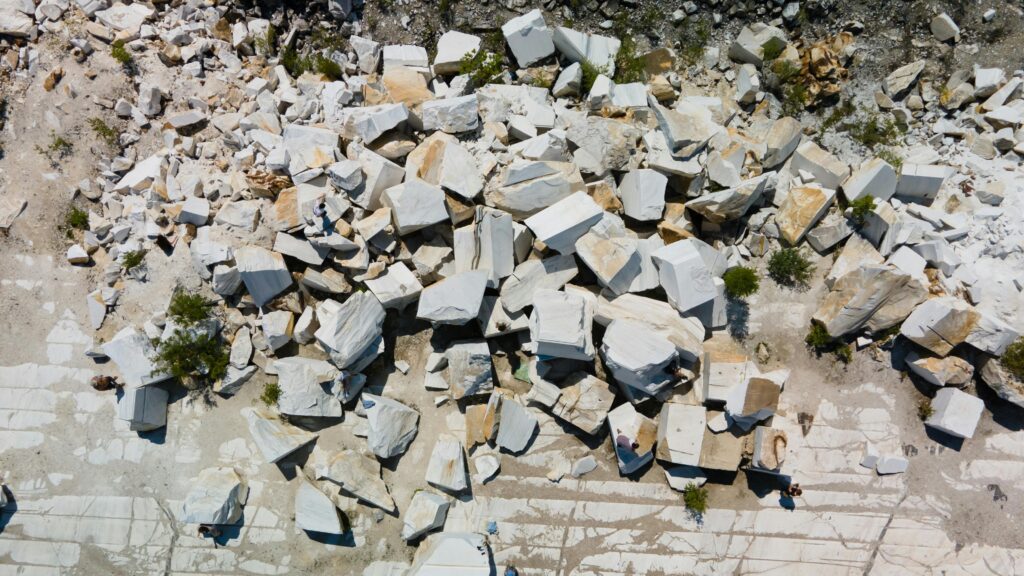Sustainability is now a key factor in marble production. Natural stones like marble and granite are important for Egypt’s economy. When we focuse on sustainable production, we can find that Egypt meets the growing demand. The Egyptian government is taking steps to meet the Sustainable Development Goals (SDGs).
As global demand for luxury and high-quality materials grows, the Egyptinan marble industry faces the challenge of balancing this demand with responsible production.
Explore how the marble industry can adopt sustainable practices, improve quality, and meet the Sustainable Development Goals (SDGs) while staying competitive in the global market.
What does Sustainability mean?
Sustainability means meeting our needs today without hurting future generations. It’s about balancing economic growth, protecting the environment, and ensuring fairness. This includes using resources wisely, reducing waste and pollution, and protecting nature. The goal is a healthier planet and a better life for everyone.
What does Sustainable marble production means?
It means to use practices that decresses environmental impact, save energy, and ensure fair labor practices. These practices not only help the industry meet the SDGs but also enhance economic growth and social responsibility. These practices are making Egyptian marble even more appealing to global markets.
Why Sustainability in Marble Production is Important?
Sustainability in marble production isn’t a trend; it’s a necessity. Global markets and consumers become more aware of the environmental impacts of production. So That industries across the board are being urged to perform sustainable practices.
The marble production involves the extraction and processing of natural stone has its own challenges. It appears especially when it comes to resource management, energy consumption, and waste.
Egyptian marble, renowned for its quality and beauty, can be a pioneer in promoting eco-friendly methods of production. The industry can be a part of healthier planet while maintaining its status as a global leader in natural stone.
The Role of Marble in Sustainable Development Goals (SDGs)
The Sustainable Development Goals (SDGs) are a plan to create a better and more sustainable future. Marble production helps achieve several of these goals. It focuses on responsible use of resources (SDG 12), taking action on climate change (SDG 13), and promoting good jobs and economic growth (SDG 8).
Egyptian Marble: A Historical Treasure with Modern Sustainability Goals
Egyptian marble has a rich history dating back to ancient civilizations that used this natural stone in construction. Today, Egypt remains a significant player in the global marble and limestone market, known for its high quality natural stone.
Incorporating sustainability into this ancient trade is essential for protecting its legacy. Modern technology allows producers to reduce environmental impact without losing marble knowen quality.
Sustainable Quarrying: Extracting Natural Stone Responsibly
The first stage of marble production—quarrying—poses significant environmental challenges. Traditional quarrying methods often lead to habitat destruction, water contamination, and landscape degradation. Sustainable quarrying aims to mitigate these effects by implementing practices like:
- Selective Quarrying: Extracting only what is necessary reduces waste and leaves surrounding ecosystems right.
- Water Management: Efficient use of water in the extraction process, with measures to prevent pollution and protect water resources.
- Reclamation of Quarries: Restoring quarry sites after extraction is complete by replanting trees and repairing the landscape to its natural state.
By using these practices, Egyptian marble producers can lower their environmental impact while still producing high-quality stone.

Energy-Efficient Marble Processing: Reducing the Carbon Footprint
Once the marble is extracted, it undergoes various stages of processing, including cutting, polishing, and finishing. These processes are traditionally energy-intensive, leading to high carbon emissions.
Advancements in technology have made it possible to reduce energy consumption significantly. By switching to renewable energy sources, such as solar power, marble production can lower its carbon footprint.
Incorporating energy-efficient machinery can further reduce energy use and costs. Additionally, using recycled water in processing helps protect resources. These steps not only benefit the environment but also enhance the sustainability of the marble industry.
After all, this shift can attract eco-conscious consumers and improve market competitiveness.
Key Steps for Energy Efficiency in Marble Production:
- Use of Automated Systems: Automated cutting machines reduce waste and optimize energy use.
- Green Power: Using solar or wind power for quarrying and processing machinery.
- Recycling Water: Reusing water in marble processing helps reduce water consumption, an important factor in dry, quarrying regions like Egypt.
Waste Management in Marble Production: Repurposing Natural Stone Byproducts
A notable challenge in marble production is the amount of waste generated during quarrying and processing.
Even So, with innovative practices, much of this waste can be recycled into usable products, reducing landfill waste and promoting sustainability.
Examples of Marble Waste Repurposing:
- Crushed Marble for Construction: Extra marble pieces and powder can be crushed and used in construction materials, such as concrete, road and paving.
- Marble Outcomes : The Secondary products of marble can be used in industries such as agriculture and cosmetics.
By recycling waste, marble industry can contribute to a circular economy, where materials are continuously reused, thus reducing the need for new raw materials.

How to Enhance Marble Quality with Sustainable Practices?
Many might assume that sustainable practices compromise the quality of marble. Even so, the opposite is true. Sustainability enhances the quality of marble production. By Highlighting precision, efficiency, and minimizing waste, which in turn, leads to better slabs and tiles.
- Consistent Slabs: Sustainable quarrying ensures marble blocks are extracted evenly, resulting in slabs with smooth textures and fewer flaws.
- Strong Finishes: Eco-friendly processing creates durable finishes on marble, making them last longer for both indoor and outdoor use. Finishes like polished, honed, or brushed remain strong and appealing.
- Preserving Natural Beauty: Sustainability safeguards the natural veins, textures, and colors of marble, especially Egyptian marble, from damage caused by harsh chemicals.
Additionally, using these methods boosts the marble’s quality and appeal. It also reduces environmental harm and preserves resources for future generations.
By promoting sustainable practices, Egyptian marble producers can meet the growing demand for eco-friendly building materials. These efforts ensure the industry’s success in the global market.Marble is a heavy material that requires careful transportation from quarries to processing plants and eventually to global markets. The transportation phase can account for a significant side of the industry’s carbon footprint.
To address this, sustainable logistics practices can be implemented:
- Local Sourcing: Reducing the distance between the quarry and the processing plant minimizes transportation-related emissions.
- Efficient Shipping: Bulk shipping methods and optimized routes lower fuel use and CO2 emissions.
- Packaging Innovations: Eco-friendly packaging, like recycled pallets and materials, cuts down on shipping waste.
These steps help reduce the environmental impact of marble production. It also making it more sustainable. In turn, this attracts clients who value green practices and increases the industry’s reputation.
The Role of Egyptian Marble in Sustainable Architecture
Egyptian marble is being integrated into sustainable architecture. Today, many people prefer natural, locally sourced materials.
Natural stone like marble offers benefits such as durability, longevity, and the ability to regulate indoor temperatures, reducing the need for artificial climate control.
In addition, using local materials supports the economy and reduces transportation emissions. Marble’s timeless beauty also adds value to any building. Its natural qualities make it a top choice for eco-friendly projects, blending both sustainability and style.
Applications in Sustainable Design:
- Marble Countertops: Egyptian marble countertops aren’t only offer beautiful appeal but are also long-lasting and resistant to wear, reducing the need for replacements.
- Wall Cladding: The use of marble in wall cladding provides natural insulation. This process is useful in lowering energy consumption for heating and cooling buildings.
- Outdoor Landscaping: Granite and marble in outdoor areas like facades, terraces, and walkways provide easy-to-maintain and eco-friendly options.

Meeting Consumer Demand: How Sustainability Adds Value to Egyptian Marble
Today, consumers become more environmentally conscious. It means that the demand for sustainably sourced products is on the rise. When sustainability is factored into marble production, Egyptian marble gained more value. Egyptian marble is already knowen with its durability, beauty and luxury.
For architects, builders, and designers, using sustainable marble meets both the style and function of a project. It also makes the project more marketable since many clients prefer to invest in eco-friendly materials.
A Future of Sustainable Egyptian Marble Production
Sustainability is no longer just an option; it’s a necessity in the global marble industry. Egyptian marble, is well-positioned to lead the way in sustainable natural stone production.
Producers will ensure that Egyptian marble remains a top choice for luxury designs with a more sustainable future. By following practices that align with the SDGs and focus on reducing environmental impact.
From energy-efficient processing to waste management and eco-friendly transportation, every part of marble production can be made more sustainable. Egyptian marble producers help protect the environment and improve the quality of their stone by following these practices. This ensures that it remains popular in both modern and traditional designs.
Additionally, sustainability practices can attract more customers who value eco-friendly options. This creates a competitive edge in the market. It also supports local communities by promoting fair labor practices. Overall, these efforts contribute to a brighter future for the marble industry.
Resources:
